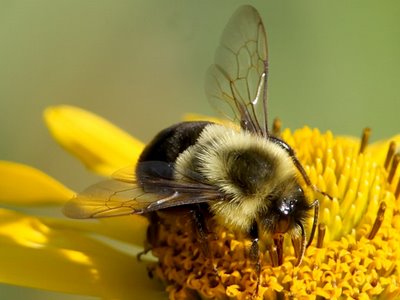Plants primarily attract pollinators by offering nectar rewards (as a source of sugar for energy) and pollen (as a protein source for developing young). In return, the pollinator will pass on the plant’s genetic material for sexual reproduction. Using this animal vector is much more efficient than relying on wind pollination, but how does the pollinator benefit from this interaction? Besides nectar and pollen, what other rewards can flowers offer? How can plants sometimes ‘deceive’ pollinators by providing a false reward?
Some neotropical plants, including orchids, produce scent which is collected by the males of Euglossine bees to use as pheromones for courtship. The bees secrete saliva full of lipids onto the floral surface, which absorbs the scent compounds and is then collected by the bee’s ‘corbicula’, a modified pollen basket. Whilst the bees are collecting these female-attracting scents, the orchid’s specialized anthers deposit a ‘pollonium’ onto the back of the bee.
Pollinators have also been found to consume floral tissues (the plant itself!) as a reward for assisting with reproduction. Beetle species often consume floral tissues but also act as pollinators. For example cycads are often pollinated by specialized weevils that eat the cycad ‘flowers’ called cones. To limit the damage done, the plants often produce low concentrations of secondary metabolite (toxins) that accumulate in the insect and this limits the amount of floral tissue the pollinator can eat.
Other specialized plant-pollinator mutualisms has the plant producing oils which are used by bees to build nests and feed larvae. In many cases these fatty acid secretions are made rather than nectar, which means a more specialized pollinator can co-evolve with the plant. This leads to more efficient pollination as the insect is limited to only travelling and distributing pollen between a few plant species.
Sometimes pollination occurs by deceit. The dead horse arum produces chemical compounds that mimic those produced by carcasses. This attracts carrion flies and traps them in the flower overnight, covering them with pollen. Orchids of the genus Ophrys emit compounds which mimic female wasp pheromones and have visual displays that look similar to female wasps. The male wasp visits and attempts to mate with the flower, but inadvertetly pollinates it if fooled twice! Neither of these plants reward the pollinator with food (or otherwise) for pollinating it- this one sided ecological interaction is known as ‘commensalism’.
Many different incentives to attract insect pollinators to specialise on a particular species (or genus) of plant exist. The bizarre strategy of the fig tree has a chalcid wasp insert its long ovipositor to lay its eggs inside the fig fruits. The fig tree grows it’s flowers inside the fig fruits so the wasp actually pollinates it in return for the plant providing a habitat and food source for the developing larvae. Other plants have been shown to ‘cheat’ and deceive their pollinators into accepting a non-existent reward (like the wild orchid wasp mimic). However recent research has found that bumblebees have a preference for plant scent compounds that give an honest indication of reward quality. Plant resources put towards reward quality is limiting however, so an equilibrium exists between the evolution of cheaters and ‘honest’ signallers.
Irwin, R. E., Adler, L. S., & Brody, A. K. (2004). The dual role of floral traits: pollinator attraction and plant defense. Ecology, 85(6), 1503-1511.
Knauer, A. C., Schiestl, F. P. (2014), Bees use honest floral signals as indicators of reward when visiting flowers. Ecology Letters. doi: 10.1111/ele.12386
Simpson, B. B., & Neff, J. L. (1981). Floral rewards: alternatives to pollen and nectar. Annals of the Missouri Botanical Garden, 301-322.
